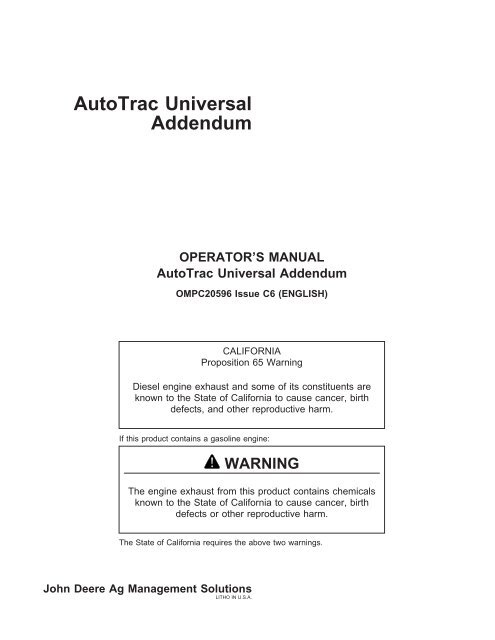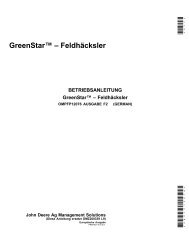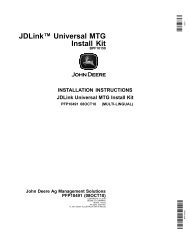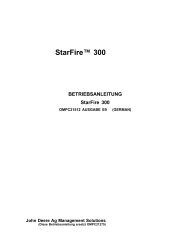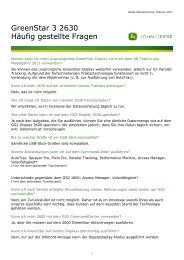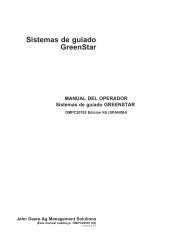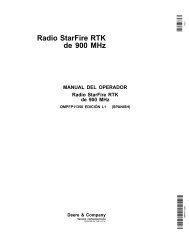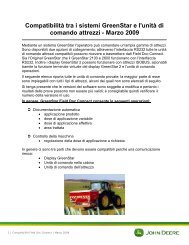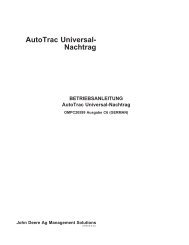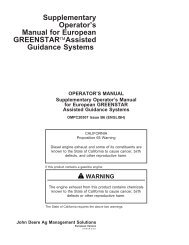AutoTrac Universal Addendum - StellarSupport - John Deere
AutoTrac Universal Addendum - StellarSupport - John Deere
AutoTrac Universal Addendum - StellarSupport - John Deere
You also want an ePaper? Increase the reach of your titles
YUMPU automatically turns print PDFs into web optimized ePapers that Google loves.
<strong>AutoTrac</strong> <strong>Universal</strong><br />
<strong>Addendum</strong><br />
OPERATOR’S MANUAL<br />
<strong>AutoTrac</strong> <strong>Universal</strong> <strong>Addendum</strong><br />
OMPC20596 Issue C6 (ENGLISH)<br />
CALIFORNIA<br />
Proposition 65 Warning<br />
Diesel engine exhaust and some of its constituents are<br />
known to the State of California to cause cancer, birth<br />
defects, and other reproductive harm.<br />
If this product contains a gasoline engine:<br />
WARNING<br />
The engine exhaust from this product contains chemicals<br />
known to the State of California to cause cancer, birth<br />
defects or other reproductive harm.<br />
The State of California requires the above two warnings.<br />
<strong>John</strong> <strong>Deere</strong> Ag Management Solutions<br />
LITHO IN U.S.A.
Foreword<br />
IMPORTANT: The following addendum is to be used<br />
only as a supplement to the GreenStar<br />
Guidance, Parallel Tracking, and<br />
<strong>AutoTrac</strong> Steering Systems operator’s<br />
manual included with your <strong>AutoTrac</strong><br />
<strong>Universal</strong> Steering Kit.<br />
WELCOME TO GREENSTAR PRECISION FARMING<br />
SYSTEMS offered by <strong>John</strong> <strong>Deere</strong>. Parallel Tracking and<br />
<strong>AutoTrac</strong> guidance systems are precision farming<br />
packages. These guidance systems are intended to aid<br />
operator to more efficiently operate machine.<br />
Introduction<br />
READ THIS MANUAL carefully to learn how to operate<br />
and service your system correctly. Failure to do so could<br />
result in personal injury or equipment damage. This<br />
manual and safety signs on your machine may also be<br />
available in other languages. (See your <strong>John</strong> <strong>Deere</strong> dealer<br />
to order.)<br />
THIS MANUAL SHOULD BE CONSIDERED a permanent<br />
part of your system and should remain with system when<br />
you sell it.<br />
MEASUREMENTS in this manual are given in both metric<br />
and customary U.S. unit equivalents. Use only correct<br />
replacement parts and fasteners. Metric and inch<br />
fasteners may require a specific metric or inch wrench.<br />
RIGHT-HAND AND LEFT-HAND sides are determined by<br />
facing in direction of forward travel.<br />
WRITE PRODUCT IDENTIFICATION NUMBERS (P.I.N.)<br />
in Specification or Identification Numbers section.<br />
Accurately record all numbers to help in tracing<br />
components should it be stolen. Your dealer also needs<br />
these numbers when you order parts. File identification<br />
numbers in a secure place off machine.<br />
GREENSTAR is a trademark of <strong>Deere</strong> & Company<br />
OUO6050,0000931 –19–21MAR06–1/2<br />
032206<br />
PN=2
WARRANTY is provided as part of <strong>John</strong> <strong>Deere</strong>’s support<br />
program for customers who operate and maintain their<br />
equipment as described in this manual. Warranty is<br />
explained on warranty certificate which you should have<br />
received from your dealer.<br />
Introduction<br />
This warranty provides you assurance that <strong>John</strong> <strong>Deere</strong><br />
will back its products where defects appear within<br />
warranty period. In some circumstances, <strong>John</strong> <strong>Deere</strong> also<br />
provides field improvements, often without charge to<br />
customer, even if product is out of warranty. Should<br />
equipment be abused, or modified to change its<br />
performance beyond original factory specifications,<br />
warranty will become void and field improvements may be<br />
denied.<br />
OUO6050,0000931 –19–21MAR06–2/2<br />
032206<br />
PN=3
Introduction<br />
032206<br />
PN=4
Contents<br />
Page<br />
SETUP<br />
<strong>AutoTrac</strong><br />
<strong>AutoTrac</strong> <strong>Universal</strong> Steering Kit ...........25-1<br />
Optimizing <strong>AutoTrac</strong> <strong>Universal</strong> Performance. ...25-5<br />
Troubleshooting<br />
<strong>AutoTrac</strong> <strong>Universal</strong> .......................80-1<br />
<strong>AutoTrac</strong> <strong>Universal</strong> Stop Codes .............80-4<br />
All information, illustrations and specifications in this manual are based on<br />
the latest information available at the time of publication. The right is<br />
reserved to make changes at any time without notice.<br />
COPYRIGHT © 2006<br />
DEERE & COMPANY<br />
Moline, Illinois<br />
All rights reserved<br />
A <strong>John</strong> <strong>Deere</strong> ILLUSTRUCTION ® Manual<br />
i 032206<br />
PN=1
Contents<br />
ii 032206<br />
PN=2
<strong>AutoTrac</strong> <strong>Universal</strong><br />
SETUP - AUTOTRAC - PAGE 1<br />
SETUP<br />
CAUTION: <strong>AutoTrac</strong> <strong>Universal</strong> does not steer<br />
properly in reverse for Articulated Tractors and<br />
Windrowers. Operator should not engage<br />
<strong>AutoTrac</strong> in reverse for Articulated Tractors and<br />
Windrowers.<br />
NOTE: Set StarFire height and fore/aft before adjusting<br />
other settings.<br />
Vehicle Type<br />
• Row Crop Tractor—If customer is using <strong>AutoTrac</strong> at<br />
high vehicle speeds, then they may choose sprayer as<br />
the vehicle type<br />
• Articulated Tractor<br />
• Windrower<br />
• Combine<br />
• Sprayer<br />
• Track Tractor<br />
• Forage Harvester<br />
• Cotton Harvester<br />
Steer Wheel Speed Determines the maximum speed the<br />
steering wheel turns to make corrections. Higher gains will<br />
turn the steering wheel faster. Lower gains are required<br />
for vehicles with slower hydraulic systems. The maximum<br />
steering wheel speed increases with steer wheel speed<br />
settings from 20 to 190. From 190 to 200 the maximum<br />
steering wheel speed stays the same, but the rate at<br />
which the steering wheel accelerates increases. The steer<br />
wheel speed should be adjusted in increments of 10<br />
between 20 and 190 and in increments of 2 between 190<br />
and 200. Setting the steer wheel speed too high may<br />
cause ATU unit to disengage. Adjust the steer wheel<br />
speed as high as possible without causing<br />
disengagements of the steering wheel.<br />
Continued on next page<br />
PC8940 –19–20MAR06<br />
OUO6050,0001AFA –19–20MAR06–1/5<br />
25-1 032206<br />
PN=7
SETUP<br />
Acquire Sensitivity Determines how aggressively the<br />
vehicle acquires the track. Higher gains will result in more<br />
aggressive steering while acquiring the track. Lower gains<br />
will give smoother entry into the next track. Setting<br />
sensitivity too high may cause vehicle instability; setting<br />
too low will delay acquisition. This setting affects<br />
performance while acquiring the track only<br />
Line Sensitivity – Tracking Determines how aggressively<br />
ATU responds to tracking errors while the vehicle is on<br />
the track. Tracking error is the distance between the<br />
vehicle’s location and the desired track. Setting this<br />
number higher will cause ATU to respond more<br />
aggressively to match the vehicle location to the desired<br />
track. Higher numbers will result in more aggressive wheel<br />
motion. Lower gains may result in reduced accuracy. This<br />
setting affects performance while on track only.<br />
Line Sensitivity – Heading Determines how aggressively<br />
ATU responds to heading errors while the vehicle is on<br />
the track. Heading error is the difference between the<br />
vehicle’s actual direction and the track direction. Setting<br />
this number higher will cause ATU to respond more<br />
aggressively to match the actual vehicle direction and<br />
track direction. Higher numbers will result in more<br />
aggressive wheel motion. Lower numbers may result in<br />
reduced accuracy. This setting affects performance while<br />
on track only.<br />
Curve Sensitivity Determines how aggressively ATU<br />
responds to a curve in the track. If the tractor is turning<br />
inside of the curve, this number should be set lower. If the<br />
tractor is turning outside of the curve, this number should<br />
be set higher. This setting affects performance in curve<br />
track only.<br />
A—Heading Error<br />
B—Tracking Error<br />
Continued on next page<br />
OUO6050,0001AFA –19–20MAR06–2/5<br />
PC8993 –UN–09MAR06<br />
PC8994 –UN–07MAR06<br />
OUO6050,0001AFA –19–20MAR06–3/5<br />
25-2 032206<br />
PN=8
Fixed-Axle Machines<br />
(Row Crop, Sprayers)<br />
SETUP - AUTOTRAC - PAGE 2<br />
SETUP<br />
StarFire Height (in.) Enter the height of the StarFire<br />
receiver. Height is measured from the ground to the top of<br />
the dome.<br />
StarFire Fore-Aft (in.) Enter the Fore-Aft measurement.<br />
This is the distance from the fixed axle of the vehicle to<br />
the receiver. The fixed axle is the rear axle on a row crop<br />
tractor and sprayer or the front axle on an articulated<br />
tractor, windrower, combine, forage harvester, and cotton<br />
harvester. For track machines this measurement shall be<br />
0. The receiver must be at or in front of the fixed axle for<br />
all machines except articulated tractors where the receiver<br />
needs to be behind the front axle.<br />
PC8995 –UN–07MAR06<br />
Articulated Machines<br />
Combines, Self-Propelled Forage Harvester, Windrower, Cotton<br />
Picker<br />
A—Height<br />
B—Fore-Aft<br />
Continued on next page<br />
PC8996 –UN–07MAR06<br />
PC8997 –UN–07MAR06<br />
OUO6050,0001AFA –19–20MAR06–4/5<br />
25-3 032206<br />
PN=9
Operator Presence Select a seat switch or operator<br />
activity monitor to detect operator presence.<br />
Disengagement Force Determines distance operator is<br />
required to move steering wheel to disengage. High<br />
setting will require more steering wheel motion before<br />
disengagement. Use high setting when rough conditions<br />
cause frequent disengagement of <strong>AutoTrac</strong> <strong>Universal</strong>.<br />
SETUP<br />
Steer Play Some vehicles may have excess play in their<br />
steering system which allows the steering wheel to be<br />
turned without change in the vehicle direction. This setting<br />
will control the distance that the steering wheel turns in<br />
order to take up this excess play. When ATU is placed on<br />
a machine that has excess play this setting should be<br />
used. This number should be set higher on vehicles which<br />
require greater steering wheel movement before the<br />
steering system responds. This setting should only be<br />
used on vehicles with excess play in their steering<br />
system. This number should be set to 0 on most vehicles<br />
except windrowers.<br />
IMPORTANT: Use <strong>AutoTrac</strong> <strong>Universal</strong> only on<br />
Approved Vehicles – see<br />
www.<strong>StellarSupport</strong>.com for list of<br />
approved vehicles<br />
It is important that the operator stay<br />
seated while vehicle is moving.<br />
When seat switch is chosen the<br />
external seat switch must be plugged<br />
into the <strong>AutoTrac</strong> <strong>Universal</strong> wiring<br />
harness. If operator leaves the seat for<br />
more than 7 seconds <strong>AutoTrac</strong> will be<br />
disengaged.<br />
When activity monitor is chosen<br />
<strong>AutoTrac</strong> <strong>Universal</strong> will look for<br />
operator activity every seven minutes.<br />
Operator will get a time out warning 15<br />
seconds before <strong>AutoTrac</strong> will<br />
disengage. Pressing resume will reset<br />
activity monitor timer.<br />
PC8941 –19–21FEB06<br />
OUO6050,0001AFA –19–20MAR06–5/5<br />
25-4 032206<br />
PN=10
Optimizing <strong>AutoTrac</strong> <strong>Universal</strong> Performance<br />
Optimizing <strong>AutoTrac</strong> <strong>Universal</strong> Performance<br />
There are six sensitivities that can be set to optimize the<br />
performance of <strong>AutoTrac</strong> <strong>Universal</strong>.<br />
SETUP<br />
Recommended Starting Adjustments<br />
Vehicle Steering Acquire Line Line<br />
Type Speed Sensitivity Sensitivity - Sensitivity -<br />
(Adjust in Tracking Heading<br />
Increments (Adjust in<br />
of 5) Increments<br />
of 20)<br />
Row Crop<br />
Tractor<br />
190 80 160 80<br />
Track<br />
Tractor<br />
190 80 160 80<br />
Articulated<br />
Tractor<br />
100 80 160 80<br />
Sprayer 190 80 160 80<br />
Combine 190 80 160 80<br />
Windrower 190 80 160 80<br />
Forage<br />
Harvester<br />
190 80 160 80<br />
Cotton<br />
Harvester<br />
190 80 160 80<br />
When operating in curves, start with the curve sensitivity<br />
equal to the optimized acquire sensitivity.<br />
These recommended settings are a good starting point for<br />
most vehicles. Each setting can be adjusted to try and<br />
optimize performance. Operator may need to readjust line<br />
sensitivity - heading and line sensitivity - tracking for best<br />
results. Increase or decrease settings to change<br />
aggressiveness as desired. If system is not responsive<br />
enough, increase sensitivity settings. If desired<br />
performance is not achieved, see TROUBLESHOOTING<br />
section for more detail.<br />
Step 1: Optimize Steer Wheel Speed<br />
• Tune speed by operating parallel to and 1.2 m (4 ft) off<br />
of the A-B Line.<br />
• Engage <strong>AutoTrac</strong> <strong>Universal</strong> and observe performance.<br />
• Tune steer wheel speed down until the system no<br />
longer disengages while acquiring the line.<br />
Continued on next page<br />
OUO6050,0001AFB –19–20MAR06–1/5<br />
25-5 032206<br />
PN=11
SETUP<br />
• While tuning, adjust in increments of 10 between Steer<br />
wheel speeds 20 – 190 and in increments of 2 between<br />
190-200.<br />
• In general, optimum performance will be achieved when<br />
steer wheel speed is set at higher settings.<br />
PC8797 –UN–21FEB06<br />
Acquire Sensitivity Too Low<br />
Step 2: Optimize Acquire Sensitivity<br />
• Tune speed by operating parallel to and 1.2 m (4 ft) off<br />
of the A-B Line.<br />
• Engage <strong>AutoTrac</strong> <strong>Universal</strong> and observe performance.<br />
• Tune Acquire Sensitivity until machine acquires the line<br />
smoothly.<br />
PC8796 –UN–21FEB06<br />
Acquire Sensitivity Too High<br />
PC8999 –UN–08MAR06<br />
A—Desired Track—Broken Line<br />
B—Actual Track—Solid Line<br />
Continued on next page<br />
OUO6050,0001AFB –19–20MAR06–2/5<br />
OUO6050,0001AFB –19–20MAR06–3/5<br />
25-6 032206<br />
PN=12
Line Sensitivities Too Low<br />
Step 3: Optimize Line Sensitivity<br />
A: Line Sensitivity—Tracking<br />
SETUP<br />
• Tune line sensitivity tracking while operating on the A-B<br />
line.<br />
• If machine wanders too far from the A-B line adjust line<br />
sensitivity – tracking higher.<br />
• If machine becomes unstable around A-B line adjust<br />
line sensitivity – tracking lower.<br />
B: Line Sensitivity—Heading<br />
• Tune line sensitivity heading while operating on the A-B<br />
line.<br />
• If the front of the machine wanders too far from the<br />
track direction adjust line sensitivity – heading higher.<br />
• If machine becomes unstable adjust line sensitivity –<br />
heading lower.<br />
NOTE: Line Sensitivities work together – If both are set<br />
too high the vehicle will become unstable. If both<br />
are set too low, the vehicle will wander around the<br />
A-B line<br />
PC8794 –UN–08MAR06<br />
Line Sensitivities Too High<br />
PC8999 –UN–08MAR06<br />
A—Desired Track—Broken Line<br />
B—Actual Track—Solid Line<br />
Continued on next page<br />
PC8795 –UN–08MAR06<br />
OUO6050,0001AFB –19–20MAR06–4/5<br />
25-7 032206<br />
PN=13
PC8944 –UN–21FEB06<br />
Curve Sensitivity<br />
Curve Sensitivity Too Low<br />
• Tune Curve Sensitivity while operating in Curve Track<br />
• If vehicle turns outside of the curve adjust sensitivity<br />
higher<br />
• If vehicle turns inside of the curve adjust sensitivity<br />
lower.<br />
Steer Play<br />
• Steer Play is only used for vehicles that have excess<br />
play in the steering system.<br />
• If overall performance is unacceptable due to high play<br />
in the steering system, adjust steer play setting higher<br />
until effects of loose steering system are minimized.<br />
• If Steer Play is set too high, system will become<br />
unstable.<br />
Find the combination of values that works best for the<br />
vehicle.<br />
SETUP<br />
PC8943 –UN–21FEB06<br />
Curve Sensitivity Too High<br />
PC8999 –UN–08MAR06<br />
A—Desired Track—Broken Line<br />
B—Actual Track—Solid Line<br />
OUO6050,0001AFB –19–20MAR06–5/5<br />
25-8 032206<br />
PN=14
<strong>AutoTrac</strong> <strong>Universal</strong><br />
Troubleshooting<br />
Symptom Problem Solution<br />
Tractor turns right or left Encoder out of range when wheels With front wheels pointed forward<br />
unexpectedly when the resume are pointed forward encoder should be +/- 500. Drive<br />
switch is pressed and the vehicle forward with wheels pointed straight<br />
is already lined up on the line. ahead until encoder is in limit.<br />
ATU disengages Anti-rotation device too tight – Re-position ATU so it slides easily<br />
causing misalignment of ATU with on steering shaft then adjust<br />
the steering shaft. anti-rotation device<br />
Steering Wheel speed too high on a Lower Steering wheel speed<br />
vehicle with high steering resistance.<br />
Looseness or rotation in the Steering Insert shims to take out play in<br />
console Steering console<br />
Steering Wheel turns hard after ATU Lubricate Steering Shaft where it<br />
installed. goes through console<br />
Disengagement force set too low for Set disengagement force setting<br />
a vehicle with high steering from normal to high.<br />
resistance.<br />
ATU unstable when entering Acquire sensitivity too high Decrease acquire sensitivity<br />
track<br />
ATU takes too long to enter next Acquire sensitivity too low Increase acquire sensitivity<br />
track<br />
Continued on next page<br />
OUO6050,0001B03 –19–20MAR06–1/3<br />
80-1 032206<br />
PN=15
Troubleshooting<br />
Symptom Problem Solution<br />
ATU constantly weaves in the StarFire Height or Fore-Aft not Enter correct StarFire Height and<br />
row properly set Fore-Aft dimension<br />
StarFire Receiver not in front of or Position StarFire in front of or even<br />
even with Fixed Axle (Even with or with Fixed Axle (Even with or Behind<br />
Behind for Articulated) for Articulated)<br />
Line sensitivities incorrect. Optimize line sensitivities (See<br />
OPTIMIZING AUTOTRAC<br />
UNIVERSAL PERFORMANCE in<br />
Setup section.)<br />
StarFire mount direction in SETUP Correctly match TCM SETUP mount<br />
different from actual mount direction direction to actual mount direction<br />
Too much play in steering Check steering cylinder bushing; tie<br />
mechanism rod ends, etc. for proper tolerance.<br />
Increase steer play<br />
ATU did not establish direction Drive forward at a speed greater<br />
correctly than 1 mph and turn steering wheel<br />
greater than 45 degrees in one<br />
direction<br />
Looseness or rotation in the Steering Insert shims to take out play in<br />
console Steering console<br />
Loose Soil Add Ballast<br />
<strong>AutoTrac</strong> <strong>Universal</strong> won’t Stop Code encountered See list of stop codes to find issue<br />
engage. <strong>AutoTrac</strong> will not<br />
resume.<br />
<strong>AutoTrac</strong> <strong>Universal</strong> does not System not recognizing <strong>AutoTrac</strong> Ensure <strong>AutoTrac</strong> <strong>Universal</strong> is<br />
appear on INFO or SETUP <strong>Universal</strong> on CAN bus line connected to GreenStar Harness<br />
screens and receiving power<br />
Continued on next page<br />
Check for blown fuses in ATU wiring<br />
harness<br />
OUO6050,0001B03 –19–20MAR06–2/3<br />
80-2 032206<br />
PN=16
Troubleshooting<br />
Symptom Problem Solution<br />
Direction can not be determined Old TCM Software Update TCM Software to newest<br />
software (Version 1.08 or greater)<br />
No differential Correction Establish differential correction<br />
No GPS Establish signal<br />
ATU did not establish direction Drive forward at a speed greater<br />
correctly than 1 mph and turn steering wheel<br />
greater than 45 degrees in one<br />
direction<br />
<strong>AutoTrac</strong> <strong>Universal</strong> drives inside Curve Sensitivity too high Lower curve sensitivity<br />
curve<br />
<strong>AutoTrac</strong> <strong>Universal</strong> drives Curve Sensitivity too low Increase curve sensitivity<br />
outside curve<br />
OUO6050,0001B03 –19–20MAR06–3/3<br />
80-3 032206<br />
PN=17
<strong>AutoTrac</strong> <strong>Universal</strong> Stop Codes<br />
Troubleshooting<br />
Stop Code Description Solution<br />
None Nothing has been checked yet<br />
Steering Wheel Steering wheel has moved to disengage Press resume switch to re-engage<br />
<strong>AutoTrac</strong> <strong>AutoTrac</strong><br />
Too Slow Vehicle speed too slow to use <strong>AutoTrac</strong> Increase speed over .5 km/h (.3 mph)<br />
Too Fast Vehicle Speed too high to use <strong>AutoTrac</strong> Reduce Speed below platform limit<br />
Tractor - 30 km/h (18.6 mph)<br />
Sprayer - 37 km/h (23 mph)<br />
Combine - 22 km/h (13.7 mph)<br />
Forage Harvester - 22 km/h (13.7 mph)<br />
Cotton Harvester - 22 km/h (13.7 mph)<br />
Reverse speed on all machines – 10<br />
km/h (6 mph)<br />
Unknown Direction Unknown direction Drive forward greater than 1.6 km/h (1<br />
mph) and turn steering wheel greater<br />
than 45°<br />
Track Changed Track number changed Align vehicle on desired track and press<br />
resume<br />
Lost Dual GPS SF1, SF2, or RTK signal was lost Establish signal<br />
SSU Error A SSU fault severe enough to disable <strong>AutoTrac</strong> Cycle power on the ATU unit and the<br />
GSD<br />
OK Last state upgrade was successful<br />
No GSD Bad GSD messages. Cycle power on GSD to try and<br />
establish communication<br />
PT Turned Off Tracking not turned on. Turn tracking on in Setup - Tracking<br />
No KeyCard <strong>AutoTrac</strong> Keycard or <strong>AutoTrac</strong> Key missing. Insert <strong>AutoTrac</strong> KeyCard<br />
Heading Error Heading error is out of range. Align tractor within heading limit (80° of<br />
track)<br />
Lateral Error Lateral error is out of range. Align tractor within lateral limit (40% of<br />
track spacing)<br />
No Operator Operator presence switch is open. Operator in seat or press resume for<br />
activity monitor to reset time<br />
No TCM Either no TCM present or TCM is turned off. Turn TCM on, or install TCM<br />
Voltage Unstable Voltage Too Low Check harnessing<br />
Reverse Timeout Reverse Timeout (greater than 45 seconds) Cycle direction forward before resuming<br />
in reverse<br />
0 Speed Timeout 0 Speed Timeout Increase speed greater then 0.5 km/h<br />
(0.3 mph)<br />
Curvature Curve Track radius tighter than <strong>AutoTrac</strong> will Manually drive through tight radius<br />
allow curves<br />
Tracking on Line Vehicle is driving on line<br />
Acquiring Line Vehicle is acquiring line<br />
OUO6050,0001B04 –19–20MAR06–1/1<br />
80-4 032206<br />
PN=18
A<br />
Index<br />
Page<br />
<strong>AutoTrac</strong> <strong>Universal</strong><br />
Troubleshooting .......................80-1<br />
T<br />
Troubleshooting<br />
<strong>AutoTrac</strong> <strong>Universal</strong> .....................80-1<br />
Index-1 032206<br />
PN=1
Index<br />
Index-2 032206<br />
PN=2


